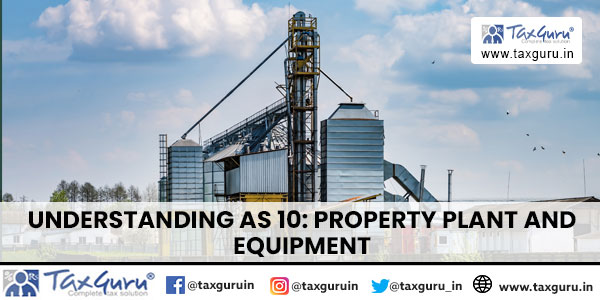SCOPE OF AS 10
Accounting Standard 10 (AS 10) pertains to “Accounting for Fixed Assets.” Its scope encompasses the recognition, measurement, valuation, depreciation, and disclosure requirements for fixed assets in financial statements. It provides guidelines for determining the initial cost of fixed assets, subsequent measurement, and accounting treatment for depreciation, impairment, and disposal of fixed assets. AS 10 ensures consistency and transparency in reporting fixed assets, thereby aiding stakeholders in assessing an entity’s financial position accurately.
OBJECTIVE
- Recognition of the assets
- Determination of carrying amount
- Depreciation charges
- Impairment losses
- Prescribed accounting treatment for property, plant and equipment
SCOPE OF AS 10
- as 10 shall be applied to accounting of PPE
- Exception: when another accounting standard requires or permits a different accounting treatment
As 10 not applicable to:
- Biological assets(other than beating plants) related to agricultural activity
- Wasting assets including mineral rights, expenditure on the exploration for the extraction of minerals, oils, natural gas and similar non regenerative resources.
DEFINATION OF PPE
In simple words it is tangible assets having life more than 12 months
- It is used in production or rendering services
- Can be used in office and administrative work
- Also for other purpose.
RECOGNITION CRITERIA OF PPE:
There are two condition top recognize PPE:
- Reliable measurement cost
- Future expected economic benefits
[SPARE PARTS AND STAND BY EQUIPMENTS: it fulfills the definition of PPE, than ur is considered as a part of PPE.If not, than it is considered as a part of inventory under AS 2]
MEASUREMEMT OF PPE:
INITIAL RECOGNITION:
It is recognised using cost model that is the cost incurred to bring PPE to the current location and condition of use.
SUBSEQUENT RECOGNITION:
- COST MODEL – total cost of assets
- REVALUATION MODEL-revise the value as per it’s fair value.

COST OF PPE:
- IF PURCHASED-
Includes all cost up to ready to use
1. purchase price deducted by subsidy, discount or rebate
2. Taxes and duties( non refundable)
3. Other costs
- If SELF CONSTRUCTION-
1. Cost of material(minus recovery)
2. Directly attributable labour and overhead up to read to use
3. Exclude internal profit
INCLUSIONS IN COST OF PPE
1. Site preparation
2. Installation
3. Registration
4. Testing and trial
5. Initial delivery and handling cost
6. Professional fees etc.
EXCLUSIONS FROM COST OF PPE:
- Cost of relocating or reorganising part or all of the operation of an enterprise
- Cost of opening new facility
- Borrowing cost unless AS 16 permits
- Cost of advertising and promotional exp.
- Abnormal wastage/loses
- Cost incurred while an item is capable of being operated in a manner as intended by management had yet to be brought into the use Or is operated at less than full capacity
TREATMENT OF SUBSEQUENT COSTS
1. Cost of day to day services
- Not recognise as PPE
- Part of repair and maintaince
- Debited to PL account
2. Replacement of parts of PPP:
- Increase existing carrying amount
- Recognise of fulfil criteria of PPE
- Derecognised existing carrying amount for replaced part
3. Similar to replacement of parts
DISCLOSURE
There are four types of disclosures:
General Disclosures
The financial statements should disclose, for each class of PPE:
(a) The measurement bases (i.e., cost model or revaluation model) used for determining the gross carrying amount;
(b) The depreciation methods used;
(c) The useful lives or the depreciation rates used. In case the useful lives or the depreciation rates used are different from those specified in the statute governing the enterprise, it should make a specific mention of that fact;
(d) The gross carrying amount and the accumulated depreciation (aggregated with accumulated impairment losses) at the beginning and end of the period; and
(e) A reconciliation of the carrying amount at the beginning and end of the period showing:
(i) additions
(ii) assets retired from active use and held for disposal
(iii) acquisitions through business combinations
(iv) increases or decreases resulting from revaluations and from impairment losses recognised or reversed directly in revaluation surplus in accordance with AS 28
(v) impairment losses recognised in the statement of profit and loss in accordance with AS 28
(vi) impairment losses reversed in the statement of profit and loss in accordance with AS 28
(vii) depreciation
(viii) net exchange differences arising on the translation of the financial statements of a non-integral foreign operation in accordance with AS 11
(ix) other changes
Additional Disclosures
The financial statements should also disclose:
(a) The existence and amounts of restrictions on title, and property, plant and equipment pledged as security for liabilities;
(b) The amount of expenditure recognised in the carrying amount of an item of property, plant and equipment in the course of its construction;
(c) The amount of contractual commitments for the acquisition of property, plant and equipment;
(d) If it is not disclosed separately on the face of the statement of profit and loss, the amount of compensation from third parties for items of property, plant and equipment that were impaired, lost or given up that is included in the statement of profit and loss; and
(e) The amount of assets retired from active use and held for disposal.
Disclosures related to Revalued Assets:
If items of property, plant and equipment are stated at revalued amounts, the following should be disclosed:
(a) The effective date of the revaluation;
(b) Whether an independent valuer was involved;
(c) The methods and significant assumptions applied in estimating fair values of the items;
(d) The extent to which fair values of the items were determined directly by reference to observable prices in an active market or recent market transactions on arm’s length terms or were estimated using other valuation techniques; and
(e) The revaluation surplus, indicating the change for the period and any restrictions on the distribution of the balance to shareholders.
(f) Disclosure of the methods adopted and the estimated useful lives or depreciation rates.
(g) Disclosures as per AS 5, applicable if any.
(h) Information on impaired PPE.
Voluntary disclosures:
An enterprise is encouraged to disclose the following:
(a) the carrying amount of temporarily idle property, plant and equipment;
(b) the gross carrying amount of any fully depreciated property, plant and equipment that is still in use;
(c) for each revalued class of property, plant and equipment, the carrying amount that would have been recognised had the assets been carried under the cost model;
(d) the carrying amount of property, plant and equipment retired from active use and not held for disposal.
Conclusion: AS 10 plays a vital role in guiding how fixed assets are accounted for in financial statements, ensuring clarity and consistency. By adhering to its principles, entities can enhance transparency and credibility in reporting their property, plant, and equipment, thereby supporting informed decision-making among stakeholders. Compliance with AS 10’s guidelines is essential for maintaining the integrity of financial reporting and fostering trust in an entity’s financial statements.
The above article is REFERRED, COMPILED and WRITTEN by SNEHAL SUBUDHI (CA inter student)





